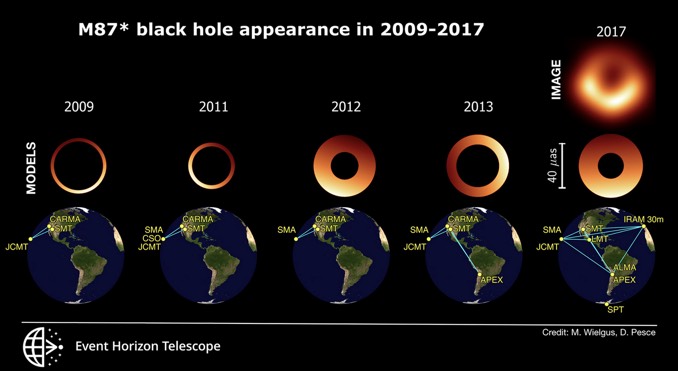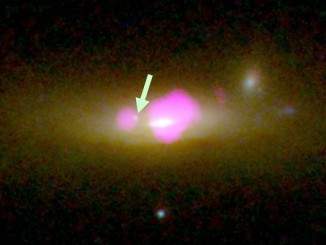
After releasing the first image of a supermassive black hole’s shadow last year, researchers combing through data collected by the Event Horizon Telescope project between 2009 and 2013 found the shadow is actually wobbling and has rotated significantly over the past decade.
The wobble is an indicator of the dynamical flow of material racing around the black hole in an accretion disc, heated to billions of degrees as it spirals inward. Being able to directly observe processes at work in the accretion disk near the black hole may shed light on how relativistic jets and other high energy-phenomena are generated.
“Because the flow of matter falling onto a black hole is turbulent, we can see that the ring wobbles with time,” said Maciek Wielgus, an astronomer at the Harvard & Smithsonian Center for Astrophysics and lead author of a paper in the Astrophysical Journal.
“Actually, we see quite a lot of variation there, and not all theoretical models of accretion flow allow for this much variability,” he added. “As we obtain more measurements in the future, we will be able to confidently put constraints on models and rule some of them out.”
The black hole in question – M87* – is located at the heart of a giant trillion-star elliptical galaxy in the Virgo cluster some 54 million light years from Earth. The central black hole has an estimated mass of 6.5 billion suns.
The Event Horizon Telescope is made up of of a global network of electronically linked radio telescopes that act together as an Earth-size interferometer. The famous image of M87*’s shadow was based on a relatively short observation window that was not long enough to show motion on short timescales.
“EHT can detect changes in the M87 morphology on timescales as short as a few days, but its general geometry should be constant on long timescales,” said Wielgus. “In 2019, we saw the shadow of a black hole for the first time, but we only saw images observed during a one-week window, which is too short to see a lot of changes.”
But combining those data with earlier observations made when the EHT utilised fewer linked observatories, researchers were able to tease out the shadow’s behaviour over the past decade, clearing showing a distinct wobble and rotation.
That wobbling is a direct indicator of the flow of gas around the black hole, shedding light – literally – on the dynamical processes going on near the hole where powerful magnetic fields create turbulence. And it may provide insights into other little-understood phenomena like the generation of relativistic jets.
“The morphology of a relativistic jet—low density outflow of tremendously energetic particles and fields, for example, is key to understanding the interactions with the surrounding medium in a black hole’s host galaxy,” said Richard Anantua, a postdoc at CFA.
The dynamics of the wobbling seen with M87* “will allow us to constrain the accretion flow,” he added. That’s important because “the accretion flow contains matter than gets close enough to the black hole to allow us to observe the effects of strong gravity, and in some circumstances, allows us to test predictions from general relativity.”



